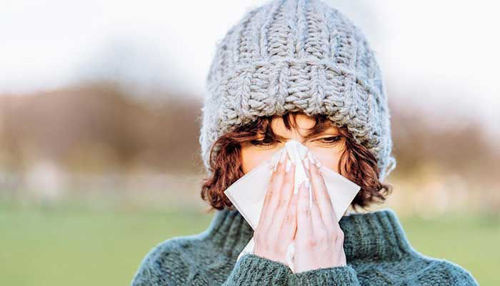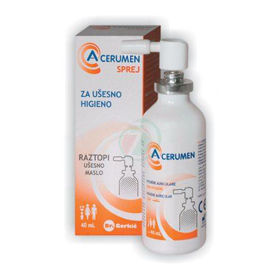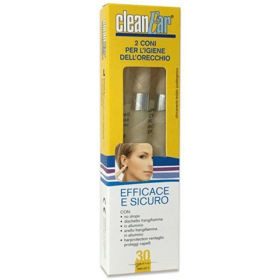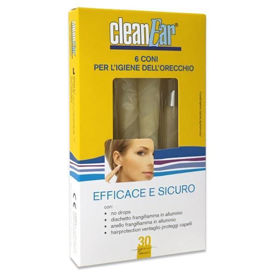Ear inflammation can be a severe and uncomfortable condition that can occur at any age. Ear infections can have many causes, including bacterial or viral infections, allergies, foreign objects in the ear, fluid retention, and the like. Treatment of inflammation usually involves using drugs such as antibiotics or antiviral drugs. In more severe cases, the doctor may prescribe a visit to a specialist or surgery.
EAR INFLAMMATION: Symptoms | Consult a doctor | Causes | Treatment | Conventional Medicine | Alternative Medicine | Treatment at home | Prevention | Questions and Answers | Sources/references
SYMPTOMS
In adults:
- painful ear (sharp, sudden pain or dull, constant pain);
- fever and chills;
- stuffy nose;
Picture: ear infection in an adult

- a feeling of tension in the ear;
- nausea and diarrhea with pain in the ear;
- muffled hearing.
In children:
- the child grabs the ear; fever;
- irritation, restlessness;
- discharge from the nose;
Picture: ear infection in a child

- reduced appetite;
- the child cries at night when he lies down.
CONSULT YOUR DOCTOR IF:
- If body temperature rises above 38° C, fever can signify a more severe infection.
- You or your child often have middle ear infections; repeated attacks can cause hearing loss or more dangerous conditions.
- You or the child have hearing problems; infection can affect hearing.
- You suspect that a young child has otitis media; it is difficult for parents to judge whether the child is deaf.
Otitis media, called an ear infection, is the most common cause of earache. It is often the cause of severe disability in infants. It is usually associated with children, but it can also affect adults. The role of the middle ear is that the bones detect the eardrum's vibrations and transmit them to the inner ear. A thin Eustachian tube connects the middle ear to the upper respiratory tract. That is why otitis media often occurs with a cold, flu, or other respiratory infection.
Video content: all about otitis media

Most parents are familiar with otitis media. In addition to regular examinations of the baby in the dispensary, otitis media is the most common reason for a visit to a pediatrician. Today, almost half of the antibiotics prescribed to children are prescribed for otitis media. Without treatment, otitis media can cause serious complications, e.g., mastoiditis (a rare inflammation of the bone behind the ear), deafness, eardrum perforation, meningitis, facial nerve palsy, and also Meniere's disease.
CAUSES
Cells in the middle ear form a liquid that, among other things, protects against infection. Usually, the fluid drains through the Eustachian tube into the pharynx. However, if the Eustachian line becomes swollen, fluid builds up in the middle ear, causing inflammation and infection. In children, the Eustachian tube lies more horizontally and is shorter, making them more susceptible to infections. A doctor sees a red and bulging eardrum in a patient with an ear infection.
Video content: the three most common causes of ear infections

The most common cause of otitis media is an upper respiratory infection, such as a cold or flu. These diseases cause the Eustachian tube to become so swollen that fluid from the middle ear cannot drain. Allergies can have the same effect - pollen, house dust, animal hair, or food - and smoke, vapors, or other environmental toxins.
Bacteria can primarily cause otitis media. Usually, a bacterial infection occurs secondary to a viral infection or an allergic reaction - microbes quickly find a place in an inflamed middle ear's warm, moist environment. Bacteria wreak havoc, turning inflammation into disease and triggering fever. The bacteria most commonly found in an inflamed middle ear are the same species that cause sinusitis, pneumonia, and other upper respiratory infections. (Note: Flu vaccination does not protect otitis media)
Inflammation of the middle ear occurs in various severe forms. A single, isolated attack, which is not difficult to cure, is called acute otitis media. It is called recurrent otitis media if the condition clears up but recurs thrice in six months (or four times in one year). If it lasts for several weeks without healing, it is chronic otitis media. Accumulation of fluid in the middle ear without infection is called serous otitis media.
Over the years, researchers have determined the characteristics of people most likely to have recurrent ear infections: men, people with a family history of middle ear infections, babies who are not breastfed (breastfed babies have less frequent ear infections);
MIDDLE EAR INFECTION
Excess fluid from the middle ear typically drains into the pharynx through the Eustachian tube. If this becomes infected - perhaps with the same microbes that cause a cold or flu - it swells, and the connection closes. As a result, fluid accumulates in the middle ear, allowing for additional infection. The accumulated fluid causes painful pressure that can cause the eardrum to rupture if the condition is not treated.
Image: a cross-sectional view of the hearing aid

children in kindergartens, people who live in a household where someone smokes, and people with weakened or impaired immune systems.
DIAGNOSTIC PROCEDURES
If you or your child have earaches, a blocked nose, a runny nose, a sore throat, and a fever, you likely have otitis media. First, the doctor will look at the eardrum with an otoscope, looking for signs of inflammation - not an easy task if the patient is a restless child.
Video content: diagnostic procedures + causes of inflammation

To determine a bacterial infection, the doctor can take a sample of fluid from the affected middle ear, which is then planted in a culture medium in the laboratory. They use this radical procedure only in complicated or very stubborn infections.
HEALING
Doctors and therapists aim to cure the middle ear infection before more severe complications arise. Treatment includes removing the cause of otitis media, killing bacteria, stimulating the immune system, and reducing the swelling of the Eustachian tube.
CONVENTIONAL MEDICINE
A viral infection usually causes otitis media; doctors can only offer medication to relieve the symptoms. Eustachian tube swelling is tried to be reduced with decongestants such as pseudoephedrine. and antihistamines, e.g., diphenhydramine. (Note: Antihistamines do not cure otitis media. They may cause mild side effects, such as drowsiness and nervousness.) To relieve pain, your doctor may prescribe analgesics, usually paracetamol, which also reduces fever. (You should not give children acetylsalicylic acid (aspirin) because of the risk of Reye's syndrome.)
About the use of antibiotics There are many conflicting opinions regarding the treatment of middle ear infections. In the UK, most doctors only treat the symptoms of otitis media without using drugs to kill the bacteria. Research has shown that this treatment method improves the condition in up to 88% of patients. At the same time, other research also confirms that 80% of otitis media is caused by viral infections and therefore does not respond to antibiotics.
Many doctors worry that the bacteria lurking in the middle ear can multiply uncontrollably and cause serious complications, such as hearing loss and mastoiditis, without antibiotics. They point out that these complications have become rare precisely because of the use of antibiotics. To be safe, many doctors treat all patients with otitis media as if bacteria were present.
Amoxicillin is the antibiotic of choice for the treatment of otitis media. It is considered a safe drug because it causes fewer allergic reactions than penicillin, from which it originates. In addition, it is very effective: taking amoxicillin for 7 to 10 days effectively destroys the infection in the middle ear and is not expensive.
Picture: amoxicillin capsule

Recently, however, doctors have noticed problems with this miracle drug. Some bacteria have learned to make a protective protein that destroys the effect of amoxicillin. Critics of the routine prescription of antibiotics charge that the uncontrolled prescription of amoxicillin for otitis media, which was not of bacterial origin, allowed the emergence of resistant (resistant) strains of bacteria.
Regardless of where they originated, resistant bacteria have emerged in many communities. This has forced doctors to prescribe other antibiotics for otitis media. Some alternative drugs, which are more expensive than amoxicillin, are from a family of antibiotics called cephalosporins. Others are a combination of drugs - e.g., amoxicillin and clavulanic acid. For example, people allergic to penicillin are prescribed sulfamethoxazole and trimethoprim or erythromycin combined with a sulfonamide, e.g., sulfisoxazole. In addition, doctors can stimulate the immune system with a vaccine that causes the immune system to recognize and attack certain bacteria in patients at least two years old.
Video content: Cephalosporin antibiotics explained

If otitis media develops serious complications, your doctor may recommend surgery to destroy the infection and remove fluid from the middle ear. In a myringotomy surgical technique, the eardrum is punctured to drain fluid from the middle ear. If the Eustachian tube is completely blocked by swelling, the surgeon may insert a ventilation tube to keep it open. However, this procedure - called a tympanostomy - is costly and can lead to infection and scarring; if the otitis media is caused by recurrent infections of the palate or pharynx, your doctor may recommend that you have them removed.
ALTERNATIVE MODES
Some alternative treatments for otitis media fight the viral or bacterial infection that causes it, while others relieve symptoms or stimulate the immune system.
AROMATHERAPY
The essential oil of lavender (Lavandula officinalis) sometimes helps to reduce inflammation and pain in otitis media. You can also use Chamomile (Matricaria recutita), evening primrose oil (Oenothera biennis), fatty acids, linseed oil, and borage oil.
AYURVEDIC MEDICINE
Ayurvedic doctors massage the lymph nodes in front of the ears to open the Eustachian tube and remove fluid from the middle ear. The massage is complemented with a drink made from the amala herb, a vitamin C source with antiviral and antibacterial effects.
Video content: Help with Ayurveda.

Amala is often combined with raw honey. (WARNING: Raw honey may contain microorganisms that cause botulism and should not be given to infants or people with weakened immune systems.)
CHINESE HERBS
Chinese doctors use special herbal mixtures to fight infection and to open the Eustachian tube. The medicines contain Scutellaria baicalensis, watercress (Alisma Plantago Aquatica), large plantain (Plantago major), Chinese gorse (Bupleurum chinense), and Ural licorice (Glycyrrhiza uralensis). Get exact recipes from a Chinese herbalist.
HERBS
Many herbs that strengthen the immune system are available in pill form - MDR. Echinacea (Echinacea spp.), chamomile (Matricaria recutita), and Hydrastis (Hydrastis Canadensis). Ear drops cannot penetrate the eardrum, so they are only helpful for outer ear infections.
HOMEOPATHY
In the early period of an ear infection that starts suddenly and is accompanied by feverish restlessness, use aconite (30 C every four or six hours). For throbbing and sharp pain accompanied by fever, intense heat, and redness of the outer ear and the side of the face, use the medicine belladonna (30 C every four or six hours).
WARNING: Be extremely careful when using belladonna, as it is an extract from a poisonous plant in the belladonna family. Consult a homeopath about dosages and carefully follow the instructions on the label.
Video content: ear pain and homeopathy

Give the medicine chamomilla to a child who has otitis media and is very irritable, has severe pain, and you cannot comfort him (30 C every four or six hours). If the child cries, clings to you, feels better in the air, and has a yellow-green nasal discharge, use pulsatilla (30 C every four or six hours). For non-infected ear fluid, try kali muriaticum (30 C every four to six hours). If there is no improvement within two days, try another remedy or consult a homeopathic specialist.
NUTRITION
You cannot cure otitis media with diet alone. Instead, dieticians recommend the following vitamins and supplements to fight viral infection.
- Beta carotene (vitamin A). You calculate the daily dose by multiplying the child's age by 20,000 IU; the maximum allowed dose is 200,000 IU.
- Vitamin C. Daily dose: child's age times 500 mg. (WARNING: High amounts of vitamin C cause diarrhea. It is essential to divide the daily dose into several smaller ones. The maximum daily dose is not strictly defined for adolescents and adults, but many people cannot tolerate more than 1000 mg every two hours.)
- Zinc. Daily dose: age times 2.5 mg. Do not take more than 50 mg per day without consulting a dietitian.
- Bioflavonoids. Daily dose: child's age times 50 mg; 250 mg is the maximum allowed dose.
OSTEOPATHY
Consult with an osteopath about treatment that could unblock the Eustachian tube.
HEALTH AT HOME
- You can ease the symptoms of otitis media at home. Heat, e.g., warm compresses, helps many patients. You can also benefit from inhaling steam and soaking your feet in hot water.
- Antihistamines deprive the body of moisture and dry out the throat and airways. If you take them, replace the liquid by drinking lots of water.
- Gagging with salt water soothes an irritated throat and opens the Eustachian tube.
- Fluid from the middle ear drains more quickly if you hold your head up.
- Some people find over-the-counter nasal sprays that work as decongestants helpful. However, if you use them for more than three days, you can become dependent on them and cause the mucous membrane to swell, worsening the condition.
PREVENTION
Bottle-fed babies have more frequent otitis media. Therefore, it is better to breastfeed your baby if possible to prevent ear infections. If you have to bottle feed him, never lay him down and lift the bottle over him.
Video content: prevention of ear infections.

Remove as many environmental pollutants as possible from home, MD. Dust, cleaners, solvents, and tobacco smoke. Allergies to hair associated with otitis media. If your child often has otitis media, try to reduce the number of wheat products, corn products, and nutritional supplements because these are more allergenic than other foods.
Questions and answers
What do inflamed ears feel like?
They are mainly itching and irritation in and around the ear canal, redness and swelling of the outer ear and ear canal, feeling of pressure and fullness in the ear, and scaly skin in and around the ear canal, which can often peel off unpleasantly.
Can the doctor notice an inflammation of the inner ear during the examination?
Inner ear infections are usually diagnosed based on symptoms and physical examination. However, a healthcare provider can often diagnose an inner ear infection based on symptoms alone. And that's a good thing because it's impossible to directly look at the internal parts of the ear during a physical examination.
How to get rid of inflammation in the ear?
How can we treat otitis media? You can treat an acute ear infection at home with a hot or cold compress. Wrap an ice or heat pack in a clean kitchen towel, wet a washcloth under hot or cold water, and hold it against your ear for up to 20 minutes. Be careful not to burn your skin when doing this.
Will the ear infection go away soon?
Many infections in the ear area quickly disappear on their own, often without significant complications, with the simultaneous use of analgesics and antibiotics. As many as 80% of these infections will be cured without antibiotics, but children younger than six months or patients with severe symptoms will generally require antibiotic therapy[1].
How long does an ear infection last?
Most inflammations of the middle ear (otitis media) disappear within three to five days after the infection, so there is no need to take particular medications. Any pain and high temperature can usually be easily alleviated with painkillers such as paracetamol or ibuprofen[2].
What causes an ear infection?
Ear inflammation is mainly caused by a bacterium or virus that finds its way into the middle ear. This infection is often the result of another illness—a cold, flu, or allergy—that causes congestion and swelling of the nasal passages, throat, and Eustachian tube[3].
Sources and references
1. Will an Ear Infection Go Away on Its Own? - https://www.heritageucpc.com
2. Middle ear infection (otitis media) - https://www.nhsinform.scot
3. Ear infection (middle ear) - https://www.mayoclinic.org












 Facebook
Facebook
 Instagram
Instagram
 info@moja-lekarna.com
info@moja-lekarna.com

